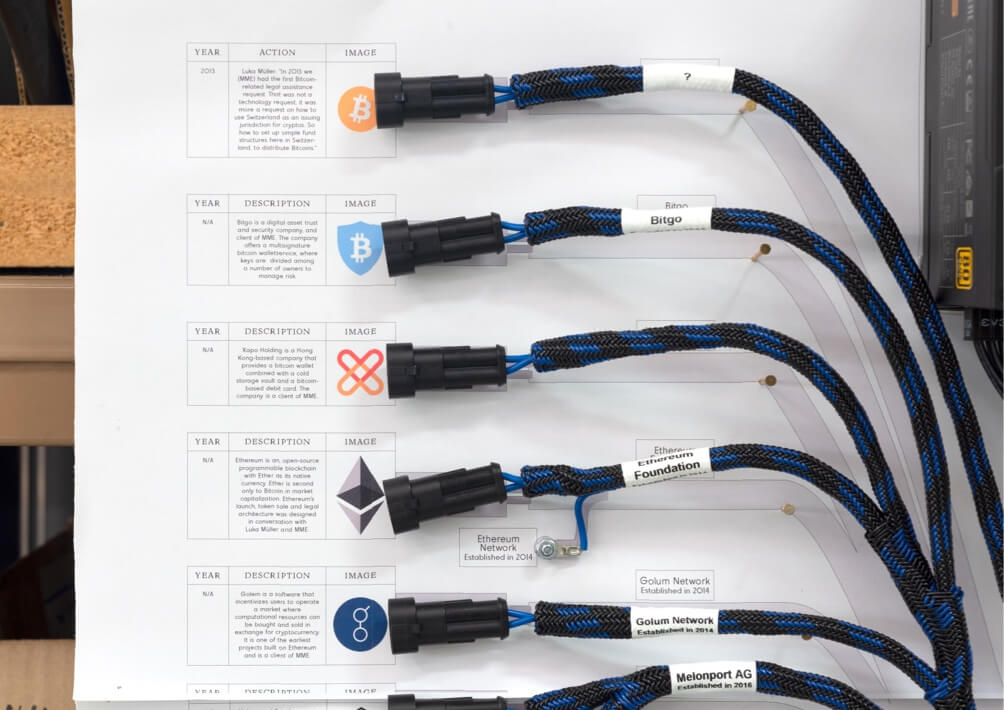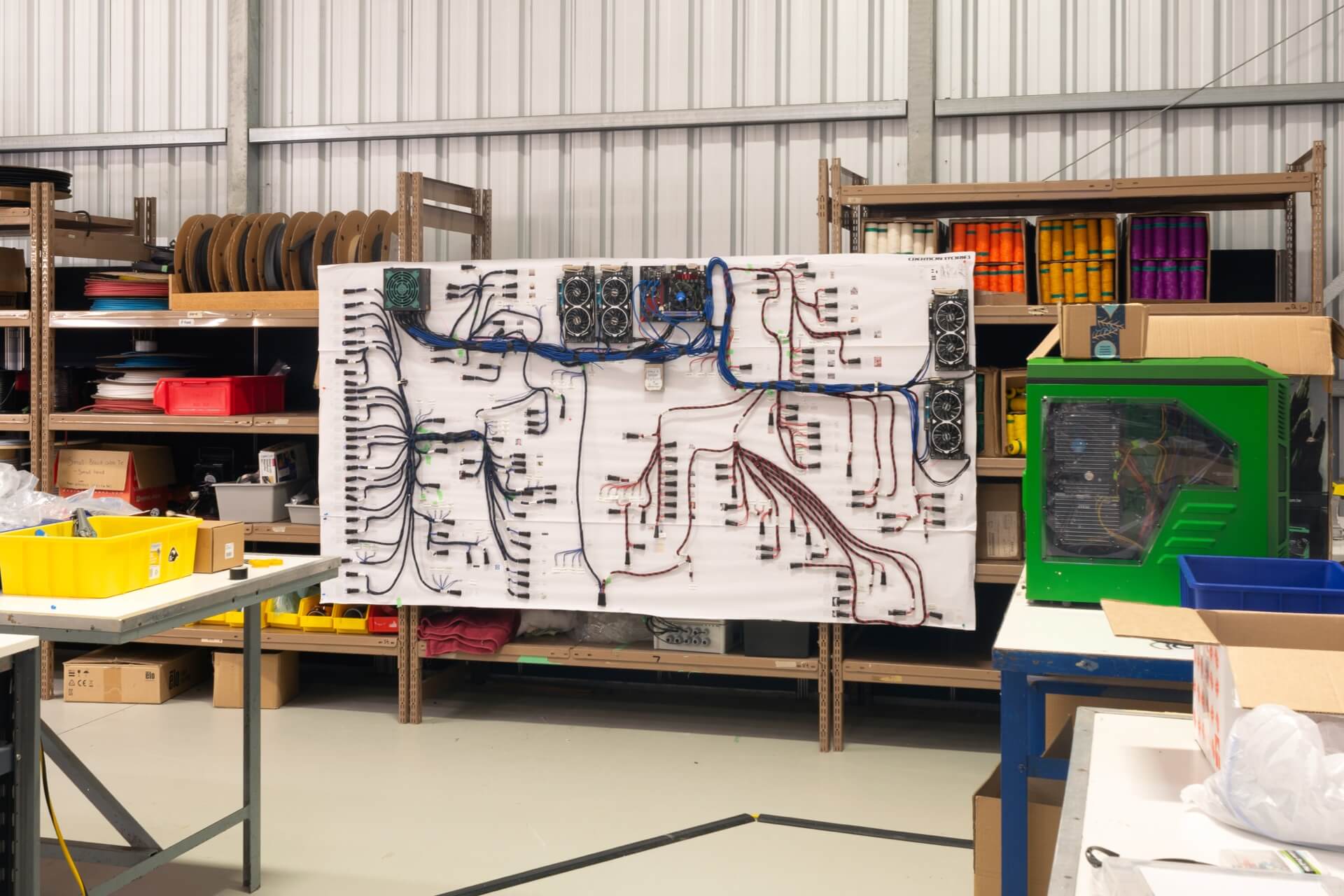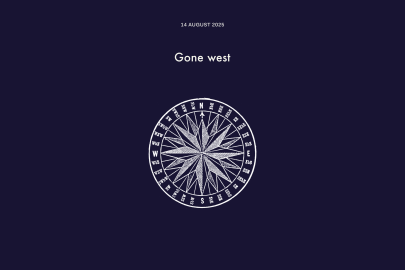Aug 23, 2022 Art
When I ask Simon Denny and Karamia Müller how they first met, they give the classic answer — “through mutual friends”. An old friend, who has been a tax lawyer, biology lab assistant and ‘twee pop’ band member, introduced the pair eight or nine years ago when Denny was home from Berlin, where he has lived for the past 15 years. They “hit it off”.
It doesn’t take much to map mutual friends in Auckland, especially those within the arts. Six degrees of separation are a couple degrees more than required in this city. But if we truly converse with each other, we may be able to make discoveries and chart beginnings beyond those of mutual friends.
In a way that’s exactly what Simon Denny and Karamia Müller have done for their upcoming collaborative project Creation Stories, opening in August. The project, co-curated by the pair, will sit in both Gus Fisher Gallery and Michael Lett, and is a highly anticipated home showing for Denny, one of our most significant contemporary artists of the moment. Creation Stories will also mark an exciting return for artist, lecturer and architectural scholar Müller after last year’s Slow Boil, the stellar show she co-convened at Artspace Aotearoa.
Creation Stories, as the title suggests, focuses on stories of creation and histories or genealogies of how we got here. By “prioritising narratives to decentralise other narratives”, as Müller puts it, the pair “play with history a little bit”. The exhibition makes connections and visualises them, Müller explains, to create a series of relational maps in different forms. Through this mapping, the duo has charted webs of entanglement — family trees of a kind — that also mimic the social graphs that entities like Facebook use as their infrastructure. The exhibition then becomes its own social graph made up of interconnected artworks and worldviews entangled with each other.
In particular, Creation Stories pairs objects or subjects which might seem separate or opposing to find the ways in which they connect. Denny and Müller themselves are one such pair. Having lived for so long in Berlin, Denny was curious as to how Müller ended up with her surname, one as common as Smith in the German-speaking world. This led to conversations about Müller’s Samoan family and the German occupation of Samoa, a legacy which Müller’s genealogy intersects with. (The surname itself comes from a Swiss great-grandfather who moved to the Pacific.) As it turned out, Denny’s own family history had a Samoan chapter: his great-grandfather was the chief justice of Samoa in the 1920s just after it passed from German to New Zealand hands.
Müller and Denny both have a longstanding interest in technology and knowledge systems — Müller has made art about software and its shortcomings in describing systems, while Denny’s art is interested in technologists and their stories and narratives about the world. The opportunity to formally collaborate, however, took a bit of time.
After Denny’s blockbuster 2017 show The Founder’s Paradox at Michael Lett, Müller offered Denny “really amazing and very considered” feedback — one day they should work together, the pair decided. A couple years later, Lisa Beauchamp, curator at Gus Fisher Gallery, invited Denny to curate an exhibition. In the time between The Founder’s Paradox and the Gus Fisher invitation, Müller and Denny’s conversations had deepened, spanning family histories, colonialism, commercial histories and cryptocurrency links.

Detail from Creation Stories
While Denny is the one with a long interest in cryptocurrencies, Müller happens to have a cousin who has been incredibly important to the development of cryptocurrency — Luka Müller from Zug, Switzerland. He is the lawyer responsible for finding the legal basis for Ethereum, perhaps the most significant cryptocurrency after Bitcoin, and co-founded a Swiss crypto bank. Denny’s family connection to currency is older and perhaps more traditional, through a great-uncle who was head of the National Bank of New Zealand during the mid-20th century. This relative too saw the birth of a pioneering new currency: overseeing the change in 1967 from British pounds to New Zealand dollars.
Uncovering these connections, the pair began a mapping exercise which overlaid personal histories with commercial, social and political histories. The result is a series of complex and messy maps of relationships and interconnections, which Denny began to recognise as social graphs just like those created by platforms like Facebook.
To make these maps physical, the pair sought inspiration from cable harnesses, the efficiently bundled wires often used in cars, aeroplanes and other complicated electronic devices. Given that all roads in this project lead back to Samoa — the very name translates to ‘sacred centre’ after all — it seems apt that cable harness assemblage is a major industry there. Mimicking the roots of a tree or a kind of skeleton, cable harnesses were very suggestive objects for the duo. Through its systematic arrangement of wires, the cable harness relays information and power around the machines it underlies. Its sprawling but coiled, interconnected nature makes it the perfect physical form for Denny and Müller’s maps. And more than just being visually useful, there’s a deeper metaphor at play here: the same way a car needs the interconnectivity of its wires to work, our own charged entanglements are what keeps the world moving.
As the maps were being conceptualised, Denny in typical fashion wondered about how to turn them into more than a diagram, “more than a genealogy”. Just as Facebook’s relational map creates value (or, more cynically, capital) for the company, so too will Denny and Müller’s. During the exhibition, as well as generating intangible artistic glory, the networks of cable harnesses will mine Ethereum — meaning that these maps of relation will literally produce cryptocurrency.
In many ways these maps are experiments in using biography as a medium. Through mapping one’s own person- al and familial histories, the creation stories that dominate how we understand the world around us may begin to look different. This use of maps emphasises relationality not hierarchy, offering a way to think through history which prioritises personal connections in the usually depersonalised narratives of nation-building, technology and colonisation.
While on the one hand Denny and Müller are mapping complex histories, a laudable project, on the other they are implicating themselves inside the complexity by using these maps of personal history to generate currency. There are multiple levels of extraction: first in the mining of their own autobiographies to create the map, and then the exploitation of having that biographical data create capital. At first, I feel as if there is something narcissistic in the project, in the way that all biography and much artwork relies on a narcissistic urge. And then I think that it mirrors the way we all extract ourselves, and let ourselves be extracted for the generation of profit, on social media. At least in this instance it’s Denny and Müller themselves who take the profit or ‘value’, rather than a corporation.
Denny says that he could only have this kind dialogue with Müller, while Müller tells me that “Simon and I differ a lot on what the artworks do”. The duo is conscious of not speaking for each other — “I’d hate to commandeer your voice,” Müller says to Denny at one point on our Zoom call. Yet, despite their distinctions, there is an inherent trust between Müller and Denny, which has enabled them to have these conversations with each other. Non-coincidentally, perhaps, trust is also a key value for Bitcoin, Denny notes.
Another question, says Müller, is “what to do about entanglement?” Can people even be disentangled? Perhaps the key is to manage the world’s tangles to reduce exploitation and improve equity. In this case, it certainly seems like great value comes from the entanglement, both intellectually and financially.
Valuing the relational over the individual seems like a useful approach to a time of particularly partisan politics. Assuming a tangled relationality to each other, or to other entities, is perhaps a more effective way to approach interpersonal interaction than to pursue atomised individualism or insist on jealous hierarchies. Perhaps the generative human tangle is something we all need more of. With time, I am sure that I could map myself on to Müller and Denny’s map — perhaps everyone could — and maybe that’s the point: we are all more connected than we may first appear.
Building an artwork out of one’s genealogy can be revealing. While we’ve seen biographical elements in Müller’s work previously, it feels newer to Denny. For a while now, Denny has been perceived as a larger-than-life but somewhat guarded artist, New Zealand’s darling expert on all things blockchain and big tech. But in this show, he’s revealing his own intellectual and familial networks of relation, which destabilise the facade of polished expertise. Artists are thought to represent entire bodies of knowledge and “feel pressure to say things on behalf of other people”. Here, though, Denny is de-mythologising himself — which he tells me is a big relief — and showing that he is just one node among many others. “The interconnectedness makes the value.”
I ask Denny and Müller about their particular use of the tools and language of big tech and bitcoin. Are they using them because that’s what they have at their disposal or because they believe genuinely in their value? “There’s a good and a bad of it that enter the room at the same time,” Denny says. It’s clear, however, that he’s the more optimistic of the pair. For Müller, the growing need to deal with the climate crisis and the ecological impact of such technology will mean something has to give eventually.
Together, Denny and Müller certainly make an unlikely but generative pair. Another pairing that the exhibition brings into focus through cable harnesses is internet infrastructure and the banyan tree, a reflection on telecommunications. In addition to the cable harness maps, the exhibition includes loaned works by Buck Nin, Dale Harding, Leah Jaynes Karp, Daniel Boyd and Michael Stevenson, which seek to add further layers and points of connection. I’m told Denny’s own high-school art boards will also be on show.
When I ask Müller and Denny what they hope audiences will take from the exhibition, Müller wishes for a curiosity of assumption, an awareness of interconnectedness and “a bunch of gripes”. “Everybody’s scared of everything,” Denny comments. He wants audiences to be able to reposition things that seem hard to rethink. There are, after all, “other ways to put the world together”.
All images: Simon Denny and Karamia Müller, detail of artwork in production at Swatek Limited, Ardmore.Creation Stories opens at Michael Lett and Gus Fisher Gallery on 6 August.
–
This feature was published in Metro 435
Available here in pdf format.






